Relaxor-PT Single Crystal Piezoelectric Sensors
Abstract
:1. Introduction
1.1. Piezoelectric Sensors
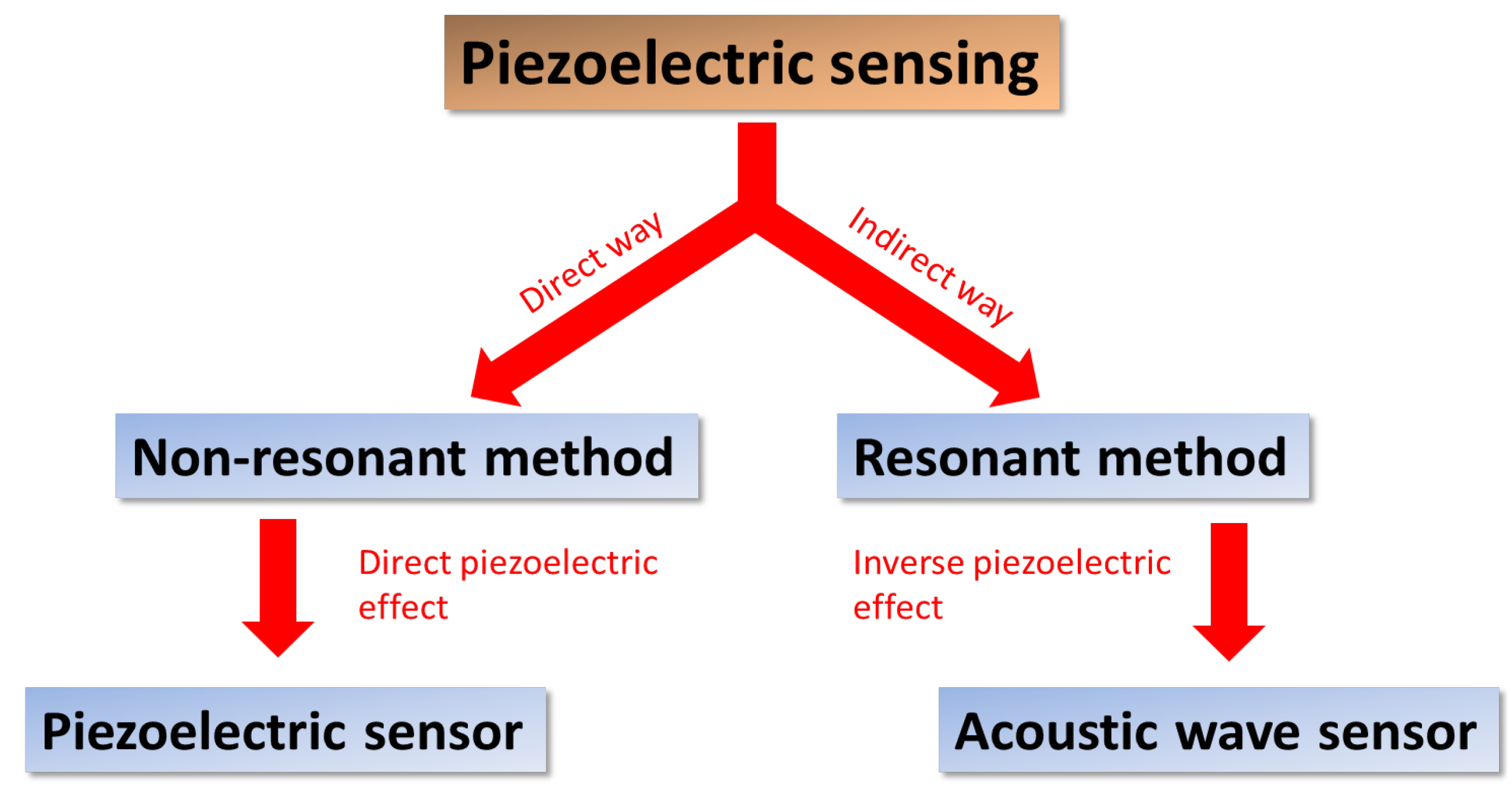
1.2. Relaxor-PT Ferroelectric Crystals
| Material | TC (°C) | d31 (pC/N) | d33 (pC/N) | k31 | k33 |  | QM | Reference |
|---|---|---|---|---|---|---|---|---|
| BaTiO3 | 115 | −78 | 190 | 0.21 | 0.50 | 1700 | 300 | [51] |
| PZT-4 | 330 | −123 | 289 | 0.33 | 0.70 | 1300 | 600 | [52] |
| PZT-5A | 370 | −171 | 374 | 0.34 | 0.71 | 1700 | 75 | [52] |
| PZT-5H | 195 | −274 | 593 | 0.39 | 0.75 | 3400 | 65 | [52] |
| PVDF | – | 21 | −32.5 | – | – | 7.6 | 8.5 | [53,54,55] |
| PMN-33%PT | 155 | −1335 | 2820 | 0.59 | 0.96 | 8200 | 100 | [25,52] |
| PZN-8%PT | – | −1075 | 2200 | 0.59 | 0.94 | 5100 | – | [56] |
| PIN-PMN-PT | 197 | −1337 | 2742 | 0.65 | 0.95 | 7244 | 120 | [57] |
| PMN-PZT | 216 | −718 | 1530 | 0.44 | 0.93 | 4850 | 100 | [58] |
| Mn:PIN-PMN-PT | 193 | – | 1120 | – | 0.90 | 3700 | 810 | [25] |
| Mn:PMN-PZT | 203 | −513 | 1140 | 0.45 | 0.92 | 3410 | 1050 | [59] |
2. Relaxor-PT Accelerometers
2.1. Bimorph Accelerometer
2.2. Unimorph Accelerometer

2.3. PIN-PMN-PT for Shear Mode Accelerometer Application
2.4. Summary
| Material | Mode | Dimension (mm3) | Sensitivity (pC/g) | Frequency range (Hz) | Reference |
|---|---|---|---|---|---|
| PZN-PT | 31 mode (flexural unimorph) | ~(6)2π × 2 | 75 | 110 * | [65] |
| PZN-PT | – | ~(18)2π × 29 | 25,000 | 0.1–200 | [66] |
| PZT | 31 mode (flexural unimorph) | ~(6)2π × 2 | 26 | 110 * | [65] |
| PZT thick film | 31 mode | 6 × 6 × 0.01 | 7.6 | 44–3,700 | [73] |
3. Relaxor-PT Hydrophones
3.1. Hydrophone Materials
3.2. Needle Hydrophone
3.3. Cymbal Hydrophone
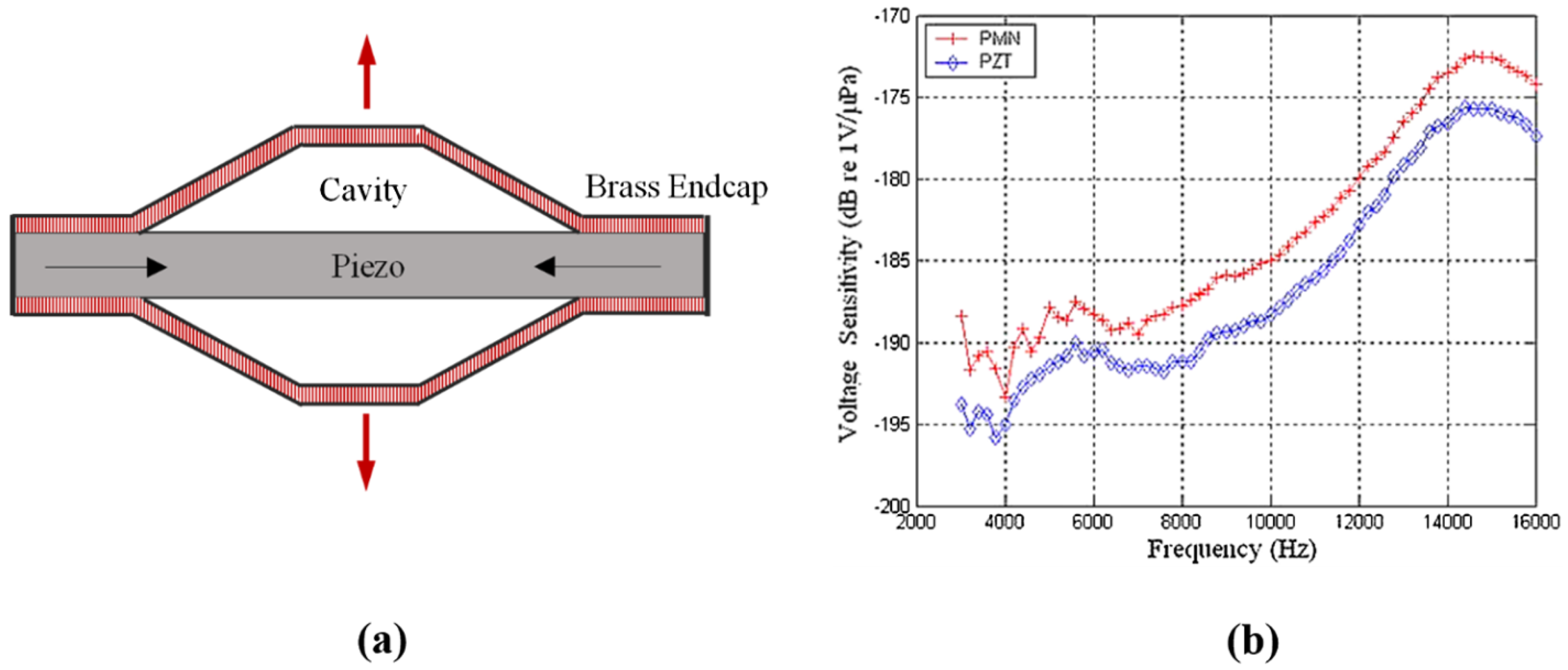
3.4. Cylinder Hydrophone
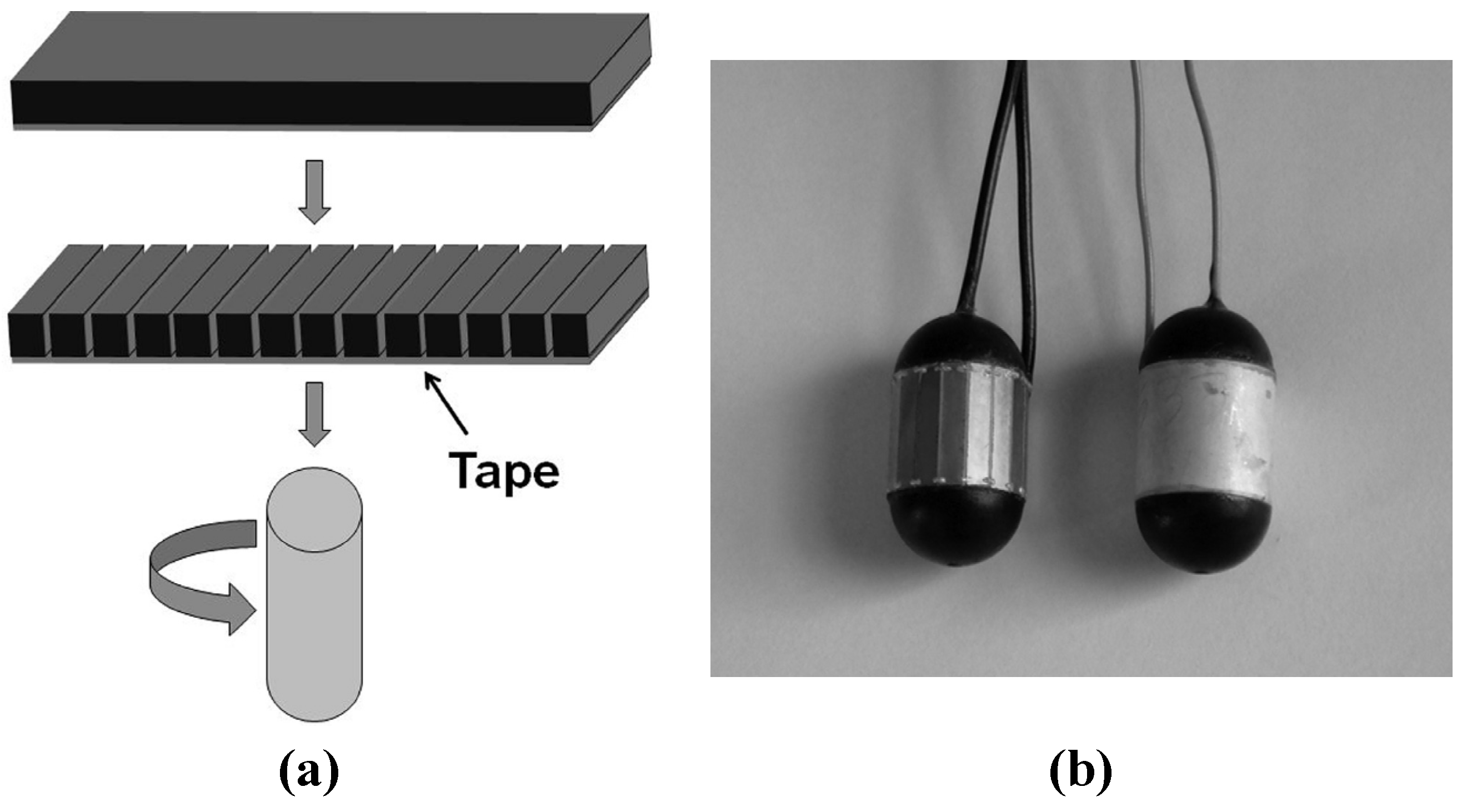
3.5. Vector Hydrophone
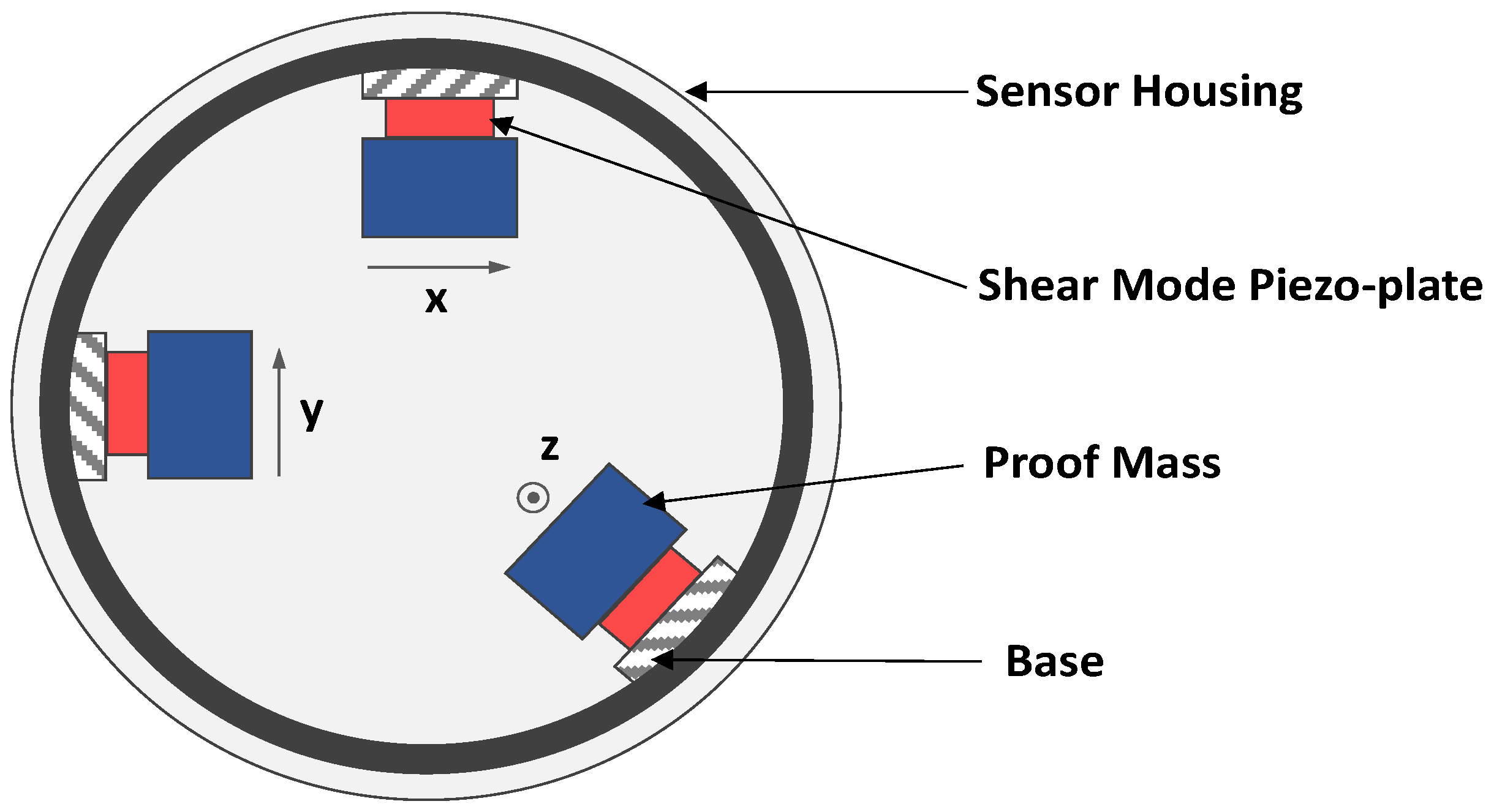
3.6. Summary
| Piezoelectric Material | Mode | Dimension | Sensitivity (dB re 1V/μPa) | Frequency Range (kHz) | Reference |
|---|---|---|---|---|---|
| PMN-PT | 33 mode (harmonic) | 0.23 (mm2) × 0.25 (mm) | −266.2 * | 17,000–24,000 | [81] |
| PMN-PT | 31 mode | 102π (mm2) × ~3 (mm) | ≥190 # | <8 | [89] |
| PMN-PT | 31 mode | (5.65)2π (mm2) | −197 | 1–8 | [74] |
| PVDF | – | 0.23 (mm2) × 0.025 (mm) | −270.2 * | 17,000–24,000 | [81] |
| PZT-5A | 31 mode | 102π (mm2) × ~3 (mm) | ≤194 # | <8 | [89] |
| PZT-5A | 31 mode | (5.65)2π (mm2) | −201 | 1–8 | [74] |
4. Relaxor-PT Surface Load Sensors
4.1. Face Shear Mode Sensor
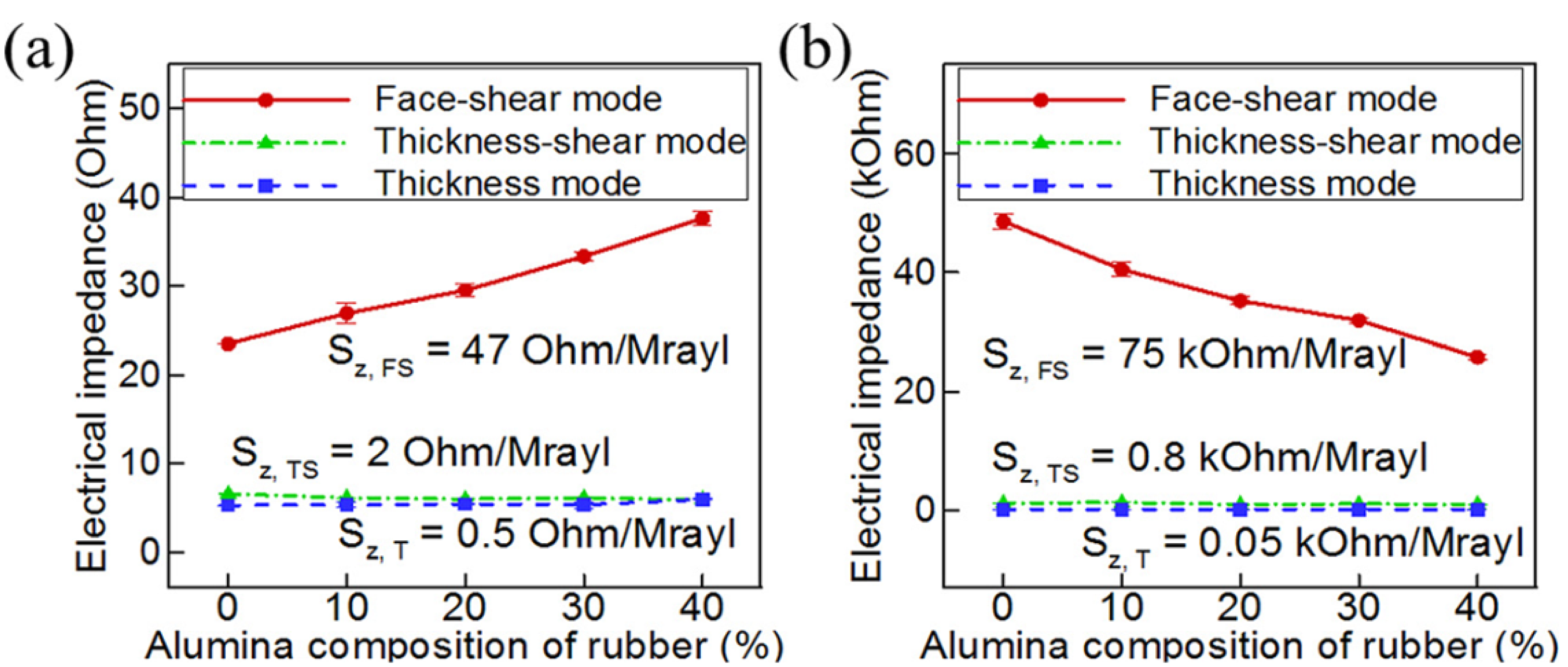
4.2. Tactile Sensor Array
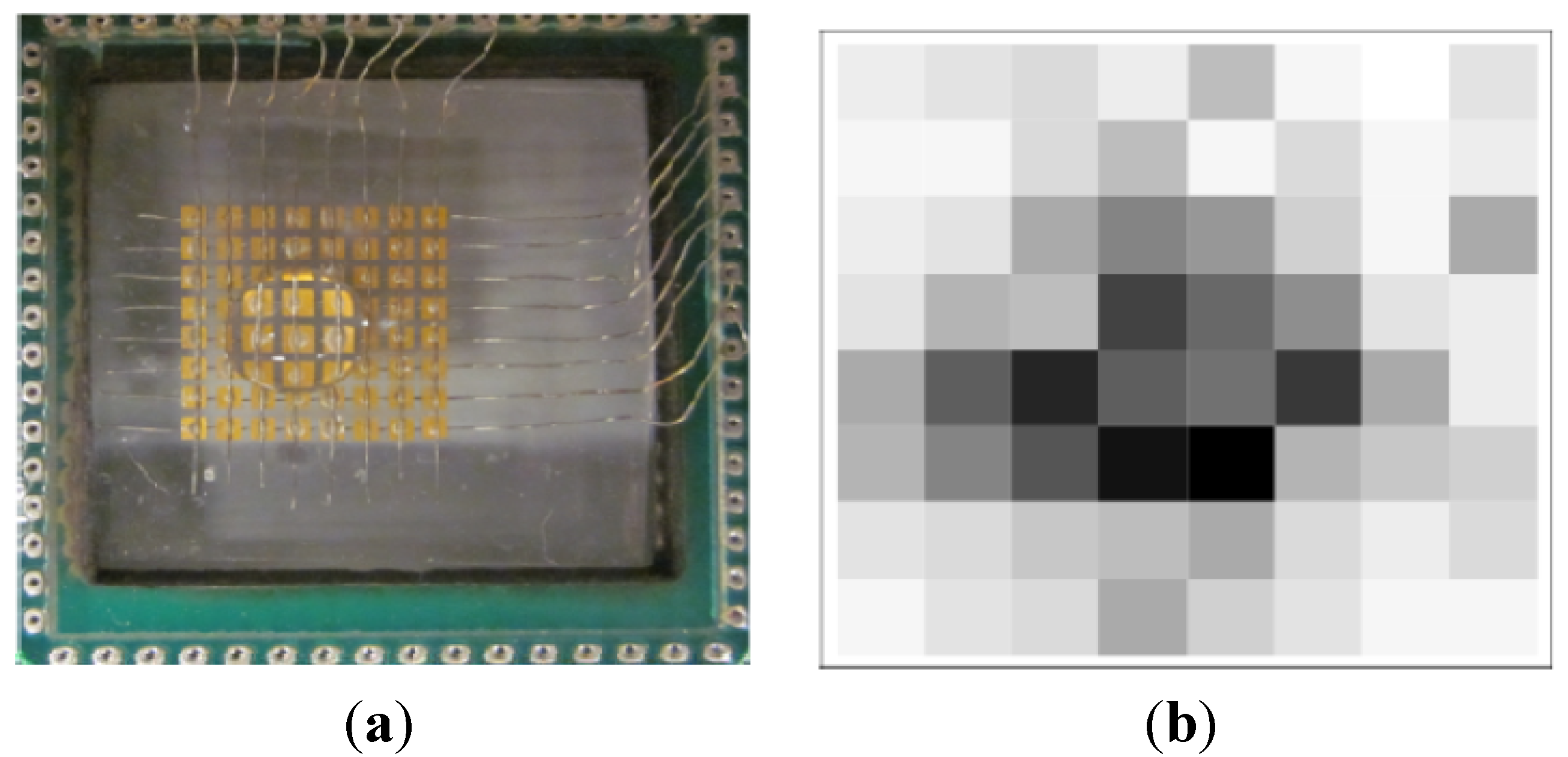
5. Relaxor-PT Bio-Chemical Sensors
5.1. Conventional Sensors
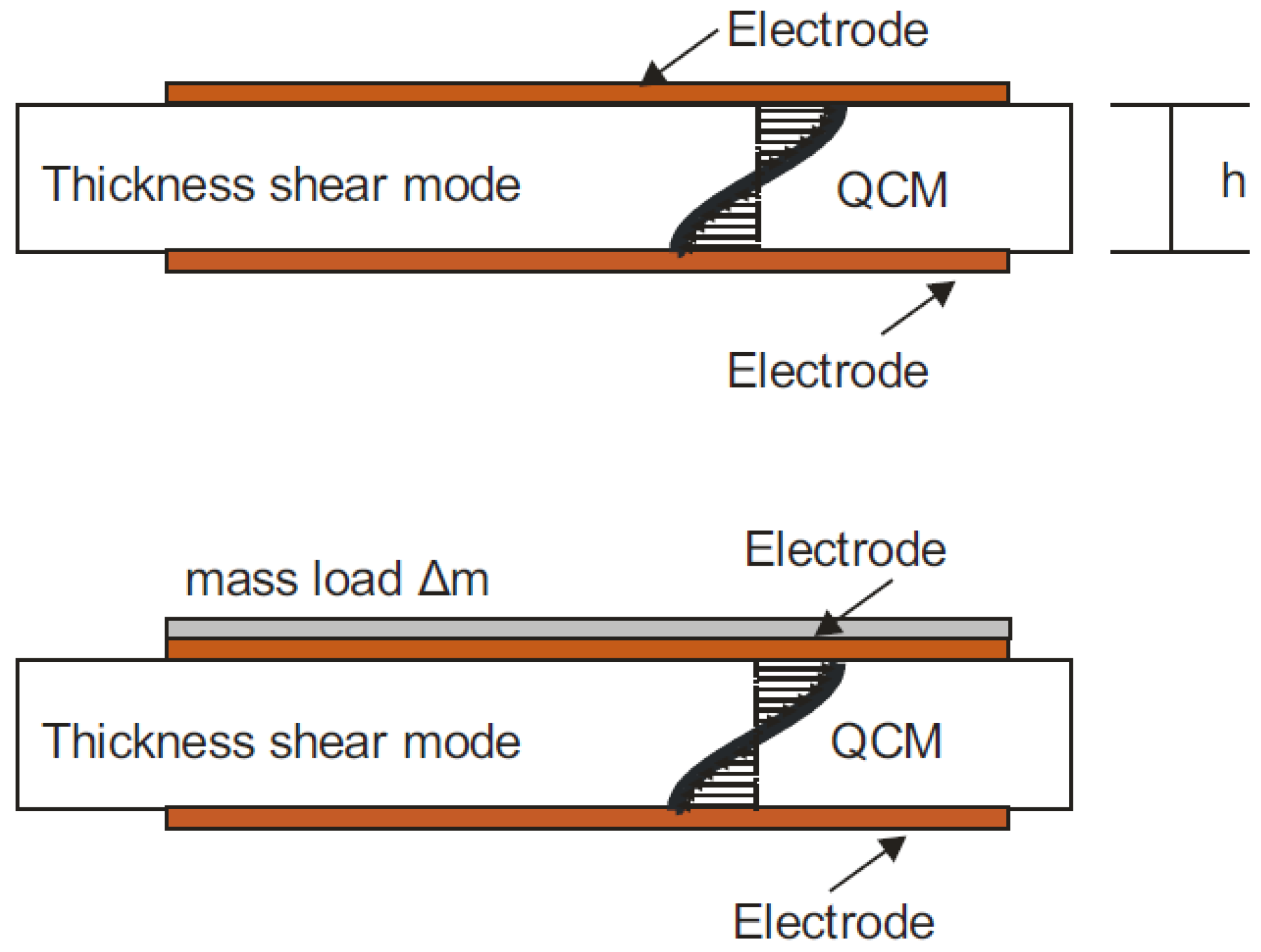
5.2. Relaxor Single Crystal Micro-Balance
5.3. SAW Sensor
5.4. PMN-PT Micro-Cantilever Sensor
5.5. PMMA-PMN-PT Sensor
6. Summary and Future Perspectives
6.1. Summary
- (a)
- High sensitivity can be achieved due to their incomparably high piezoelectric constants;
- (b)
- Due to their high dielectric constants, electrical matching with associated electrical systems and a quasi-static measurement by direct piezoelectric effect becomes more practical;
- (c)
- Sensors operating as a non-resonant type can exhibit low noise level at low frequency range due to their low loss tangent;
- (d)
- The optimal piezoelectric property for the designated sensing mode (thickness mode, lateral extension mode, thickness shear mode, and face shear mode) can be achieved by engineering the crystal cut and poling directions;
- (e)
- As a fabrication or a maintenance procedure of thickness mode, lateral mode, and face shear mode sensors, the poling process is much easier than PZT ceramics and PVDF films, due to their low coercive field.
- (a)
- Although the growth method for large crystals have been demonstrated [25], relaxor-PT single crystals still cost more than the lead-based piezo-ceramics;
- (b)
- (c)
- Low Curie temperature, phase transition temperature, and coercive field of the first generation relaxor single crystals are not favorable for piezoelectric sensors;
- (d)
- High thermal sensitivity of the relaxor crystals requires a proper compensation for the accurate sensing of purposed mechanical stimulus.
6.2. Future Perspectives
6.2.1. The Second Generation Crystals
6.2.2. The Third Generation Crystals
6.2.3. Cryogenic Sensors
Author Contributions
Conflicts of Interest
References
- Bell, D.; Lu, T.; Fleck, N.; Spearing, S. MEMS actuators and sensors: Observations on their performance and selection for purpose. J. Micromec. Microeng. 2005, 15. [Google Scholar] [CrossRef]
- Tabib-Azar, M.; Garcia-Valenzuela, A. Sensing means and sensor shells: A new method of comparative study of piezoelectric, piezoresistive, electrostatic, magnetic, and optical sensors. Sens. Actuators A 1995, 48, 87–100. [Google Scholar] [CrossRef]
- Kim, K.; Zhang, S.; Huang, W.; Yu, F.; Jiang, X. YCa4O(BO3)3 (YCOB) high temperature vibration sensor. J. Appl. Phys. 2011, 109, 126103:1–126103:3. [Google Scholar]
- Kim, K.; Zhang, S.; Jiang, X. Surface acoustic load sensing using a face-shear PIN-PMN-PT single-crystal resonator. IEEE Trans. Ultrason. Ferroelectr. Freq. Control 2012, 59. [Google Scholar] [CrossRef]
- Wilson, J.S. Sensor Technology Handbook; Newnes: Burlington, MA, USA, 2005. [Google Scholar]
- Tadigadapa, S.; Mateti, K. Piezoelectric MEMS sensors: State-of-the-art and perspectives. Meas. Sci. Technol. 2009, 20, 092001:1–092001:30. [Google Scholar]
- Drafts, B. Acoustic wave technology sensors. IEEE Trans. Microw. Theory Tech. 2001, 49, 795–802. [Google Scholar] [CrossRef]
- Vellekoop, M.J. Acoustic wave sensors and their technology. Ultrasonics 1998, 36, 7–14. [Google Scholar] [CrossRef]
- Nikolelis, D.P.; Varzakas, T.; Erdem, A.; Nikoleli, G. Portable Biosensing of Food Toxicants and Environmental Pollutants; CRC Press: Boca Raton, FL, USA, 2014. [Google Scholar]
- Mi, X.; He, F.; Xiang, M.; Lian, Y.; Yi, S. Novel phage-piezoelectric sensor for rapid drug susceptibility testing of Mycobacterium tuberculosis. Sens. Actuators B 2014, 193, 715–722. [Google Scholar] [CrossRef]
- Li, X.; Zhao, B.; Li, S.; Wu, X.; Ren, W.; Shi, P.; Ye, Z. Resonance Behavior of Piezoelectric Polymer Diaphragms for Biosensors. Ferroelectrics 2014, 459, 38–45. [Google Scholar] [CrossRef]
- Choi, W.; Lee, J.; Yoo, Y.K.; Kang, S.; Kim, J.; Lee, J.H. Enhanced sensitivity of piezoelectric pressure sensor with microstructured polydimethylsiloxane layer. Appl. Phys. Lett. 2014, 104, 123701:1–123701:4. [Google Scholar]
- Yong, Y.K.; Fleming, A.J.; Moheimani, S.R. A novel piezoelectric strain sensor for simultaneous damping and tracking control of a high-speed nanopositioner. Trans. Mechatron. IEEE/ASME 2013, 18, 1113–1121. [Google Scholar] [CrossRef]
- Tomimatsu, Y.; Takahashi, H.; Kuwana, K.; Kobayashi, T.; Matsumoto, K.; Shimoyama, I.; Itoh, T.; Maeda, R. A piezoelectric flow sensor for use as a wake-up switch for a wireless sensor network node. Mechatronics 2013, 23, 893–897. [Google Scholar] [CrossRef]
- Schmidtchen, S.; Richter, D.; Fritze, H. Variation of the vibration profile of piezoelectric resonant sensors with different electrode conductivity at high temperatures. Sens. Actuators B 2013, 187, 247–253. [Google Scholar] [CrossRef]
- Benes, E.; Gröschl, M.; Burger, W.; Schmid, M. Sensors based on piezoelectric resonators. Sens. Actuators A 1995, 48, 1–21. [Google Scholar] [CrossRef]
- Tressler, J.F.; Alkoy, S.; Newnham, R.E. Piezoelectric sensors and sensor materials. J. Electroceramics 1998, 2, 257–272. [Google Scholar] [CrossRef]
- Jiang, X.; Kim, K.; Zhang, S.; Johnson, J.; Salazar, G. High-Temperature Piezoelectric Sensing. Sensors 2013, 14, 144–169. [Google Scholar] [CrossRef]
- Heywang, W.; Lubitz, K.; Wersing, W. Piezoelectricity: Evolution and Future of a Technology; Springer: New York, NY, USA, 2008; Volume 114. [Google Scholar]
- Scott, J. Applications of modern ferroelectrics. Science 2007, 315, 954–959. [Google Scholar] [CrossRef]
- Cross, L.E. Relaxor ferroelectrics. Ferroelectrics 1987, 76, 241–267. [Google Scholar] [CrossRef]
- Park, S.-E.; Shrout, T.R. Ultrahigh strain and piezoelectric behavior in relaxor based ferroelectric single crystals. J. Appl. Phys. 1997, 82, 1804–1811. [Google Scholar] [CrossRef]
- Fu, H.; Cohen, R.E. Polarization rotation mechanism for ultrahigh electromechanical response in single-crystal piezoelectrics. Nature 2000, 403, 281–283. [Google Scholar] [CrossRef]
- Davis, M. Picturing the elephant: Giant piezoelectric activity and the monoclinic phases of relaxor-ferroelectric single crystals. J. Electroceramics 2007, 19, 25–47. [Google Scholar] [CrossRef]
- Zhang, S.; Li, F. High performance ferroelectric relaxor-PbTiO3 single crystals: Status and perspective. J. Appl. Phys. 2012, 111, 031301:1–031301:50. [Google Scholar]
- Kuwata, J.; Uchino, K.; Nomura, S. Phase transitions in the Pb(Zn1/3Nb2/3)O3-PbTiO3 system. Ferroelectrics 1981, 37, 579–582. [Google Scholar] [CrossRef]
- Kuwata, J.; Uchino, K.; Nornura, S. Dielectric and piezoelectric properties of 0.91Pb(Zn1/3Nb2/3)O3-0.09PbTiO3 single crystals. Jpn. J. Appl. Phys. 1982, 21, 1298–1302. [Google Scholar] [CrossRef]
- Park, S.-E.; Shrout, T.R. Characteristics of relaxor-based piezoelectric single crystals for ultrasonic transducers. IEEE Trans. Ultrason. Ferroelectr. Freq. Control. 1997, 44, 1140–1147. [Google Scholar] [CrossRef]
- Zhang, R.; Jiang, B.; Cao, W. Elastic, piezoelectric, and dielectric properties of multidomain 0.67Pb(Mg1/3Nb2/3)O3-0.33PbTiO3 single crystals. J. Appl. Phys. 2001, 90, 3471–3475. [Google Scholar] [CrossRef]
- Ye, Z.-G. Crystal chemistry and domain structure of relaxor piezocrystals. Curr. Opin. Solid State Mater. Sci. 2002, 6, 35–44. [Google Scholar] [CrossRef]
- Zhang, R.; Jiang, B.; Jiang, W.; Cao, W. Anisotropy in domain engineered 0.92Pb(Zn1/3/Nb2/3)O3-0.08PbTiO3 single crystal and analysis of its property fluctuations. IEEE Trans. Ultrason. Ferroelectr. Freq. Control 2002, 49, 1622–1627. [Google Scholar] [CrossRef]
- Zhang, S.; Laurent, L.; Liu, S.; Rhee, S.; Randall, C.A.; Shrout, T.R. Piezoelectric shear coefficients of Pb(Zn1/3Nb2/3)O3-PbTiO3 single crystals. Jpn. J. Appl. Phys. 2002, 41. [Google Scholar] [CrossRef]
- Dammak, H.; Renault, A.-É.; Gaucher, P.; Thi, M.P.; Calvarin, G. Origin of the giant piezoelectric properties in the [001] domain engineered relaxor single crystals. Jpn. J. Appl. Phys. 2003, 42. [Google Scholar] [CrossRef]
- Zhang, R.; Jiang, B.; Cao, W. Single-domain properties of 0.67Pb(Mg1/3Nb2/3)O3-0.33PbTiO3 single crystals under electric field bias. Appl. Phys. Lett. 2003, 82, 787–789. [Google Scholar] [CrossRef]
- Zhang, S.; Lebrun, L.; Jeong, D.-Y.; Randall, C.A.; Zhang, Q.; Shrout, T.R. Growth and characterization of Fe-doped Pb(Zn1/3Nb2/3)O3-PbTiO3 single crystals. J. Appl. Phys. 2003, 93, 9257–9262. [Google Scholar] [CrossRef]
- Shanthi, M.; Hoe, K.; Lim, C.; Lim, L. Overpoling-induced property degradation in Pb(Mg1/3Nb2/3)O3-PbTiO3 single crystals of near-morphotropic phase boundary compositions. Appl. Phys. Lett. 2005, 86, 262908:1–262908:3. [Google Scholar]
- Shrout, T.R.; Chang, Z.P.; Kim, N.; Markgraf, S. Dielectric behavior of single crystals near the (1−x)Pb(Mg1/3Nb2/3)O3-(x)PbTiO3 morphotropic phase boundary. Ferroelectr. Lett. Sect. 1990, 12, 63–69. [Google Scholar] [CrossRef]
- Hurle, D.T. Handbook of Crystal Growth; Elsevier: New York, NY, USA, 1994. [Google Scholar]
- Moulson, A.J.; Herbert, J.M. Electroceramics: Materials, Properties, Applications, 2nd ed.; John Wiley & Sons: Chichester, West Sussex, UK, 2003. [Google Scholar]
- Lim, L.; Shanthi, M.; Rajan, K.; Lim, C. Flux growth of high-homogeneity PMN-PT single crystals and their property characterization. J. Cryst. Growth 2005, 282, 330–342. [Google Scholar] [CrossRef]
- Zhang, S.; Li, F.; Luo, J.; Xia, R.; Hackenberger, W.; Shrout, T.R. Investigation of single and multidomain Pb(In0.5Nb0.5)O3-Pb(Mg1/3Nb2/3)O3-PbTiO3 crystals with mm2 symmetry. Appl. Phys. Lett. 2010, 97, 132903:1–132903:3. [Google Scholar]
- Cao, H.; Schmidt, V.H.; Zhang, R.; Cao, W.; Luo, H. Elastic, piezoelectric, and dielectric properties of 0.58Pb(Mg1/3Nb2/3)O3-0.42PbTiO3 single crystal. J. Appl. Phys. 2004, 96, 549–554. [Google Scholar] [CrossRef]
- Zhang, Y.; Liu, D.A.; Zhang, Q.; Wang, W.; Ren, B.; Zhao, X.; Luo, H. Complete Set of Material Constants of <011>-Poled Rhombohedral Single-Crystal 0.25Pb(In1/2Nb1/2)O3-0.47Pb(Mg1/3Nb2/3)O3-0.28PbTiO3. J. Electron. Mater. 2011, 40, 92–96. [Google Scholar] [CrossRef]
- Liu, X.; Zhang, S.; Luo, J.; Shrout, T.R.; Cao, W. A complete set of material properties of single domain 0.26Pb(In1/2Nb1/2)O3-0.46Pb(Mg1/3Nb2/3)O3-0.28PbTiO3 single crystals. Appl. Phys. Lett. 2010, 96, 012907:1–012907:3. [Google Scholar]
- Li, F.; Zhang, S.; Xu, Z.; Wei, X.; Luo, J.; Shrout, T.R. Electromechanical properties of tetragonal Pb(In1/2Nb1/2)O3-Pb(Mg1/3Nb2/3)O3-PbTiO3 ferroelectric crystals. J. Appl. Phys. 2010, 107, 054107:1–054107:5. [Google Scholar]
- Zhang, S.; Randall, C.A.; Shrout, T.R. Characterization of perovskite piezoelectric single crystals of 0.43BiScO3-0.57PbTiO3 with high Curie temperature. J. Appl. Phys. 2004, 95, 4291–4295. [Google Scholar] [CrossRef]
- Kim, J.; Joh, C.; Roh, Y. Evaluation of All the Material Constants of PMN-28% PT Piezoelectric Single Crystals for Acoustic Transducers. Sens. Mater. 2013, 25, 539–552. [Google Scholar]
- Joh, C.; Kim, J.; Roh, Y. Determination of the complex material constants of PMN-28% PT piezoelectric single crystals. Smart Mater. Struct. 2013, 22, 125027:1–125027:8. [Google Scholar]
- Park, S.-E.; Shrout, T.R. Relaxor based ferroelectric single crystals for electro-mechanical actuators. Mater. Res. Innov. 1997, 1, 20–25. [Google Scholar] [CrossRef]
- Park, S.-E.E.; Hackenberger, W. High performance single crystal piezoelectrics: Applications and issues. Curr. Opin. Solid State Mater. Sci. 2002, 6, 11–18. [Google Scholar] [CrossRef]
- Mattiat, O.E.; Belincourt, D.; Kikuchi, Y.; Meitzier, A.H. Ultrasonic Transducer Materials; Plenum Press: New York, NY, USA, 1971. [Google Scholar]
- Sherman, C.H.; Butler, J.L. Transducers and Arrays for Underwater Sound; Springer: New York, NY, USA, 2007. [Google Scholar]
- Nix, E.; Ward, I. The measurement of the shear piezoelectric coefficients of polyvinylidene fluoride. Ferroelectrics 1986, 67, 137–141. [Google Scholar] [CrossRef]
- Schewe, H. Piezoelectricity of uniaxially oriented polyvinylidene fluoride. In Proceedings of 1982 Ultrasonics Symposium, San Diego, CA, USA, 27–29 October 1982; pp. 519–524.
- Kwok, K.W.; Chan, H.L.W.; Choy, C.L. Evaluation of the material parameters of piezoelectric materials by various methods. IEEE Trans. Ultrason. Ferroelectr. Freq. Control 1997, 44, 733–742. [Google Scholar] [CrossRef]
- Ritter, T.; Geng, X.; Shung, K.K.; Lopath, P.D.; Park, S.-E.; Shrout, T.R. Single crystal PZN/PT-polymer composites for ultrasound transducer applications. IEEE Trans. Ultrason. Ferroelectr. Freq. Control 2000, 47, 792–800. [Google Scholar] [CrossRef]
- Liu, X.; Zhang, S.; Luo, J.; Shrout, T.R.; Cao, W. Complete set of material constants of Pb(In1/2Nb1/2)O3-Pb(Mg1/3Nb2/3)O3-PbTiO3 single crystal with morphotropic phase boundary composition. J. Appl. Phys. 2009, 106, 074112:1–074112:14. [Google Scholar]
- Zhang, S.; Lee, S.-M.; Kim, D.-H.; Lee, H.-Y.; Shrout, T.R. Temperature dependence of the dielectric, piezoelectric, and elastic constants for Pb(Mg1/3Nb2/3)O3-PbZrO3-PbTiO3 piezocrystals. J. Appl. Phys. 2007, 102, 114103:1–114103:5. [Google Scholar]
- Zhang, S.; Lee, S.-M.; Kim, D.-H.; Lee, H.-Y.; Shrout, T.R. Characterization of Mn-modified Pb(Mg1/3Nb2/3)O3-PbZrO3-PbTiO3 single crystals for high power broad bandwidth transducers. Appl. Phys. Lett. 2008, 93, 122908:1–122908:3. [Google Scholar]
- Zhang, S.; Shrout, T.R. Relaxor-PT single crystals: Observations and developments. IEEE Trans. Ultrason. Ferroelectr. Freq. Control 2010, 57, 2138–2146. [Google Scholar] [CrossRef]
- Zhang, S.; Li, F.; Luo, J.; Sahul, R.; Shrout, T.R. Relaxor-PbTiO3 single crystals for various applications. IEEE Trans. Ultrason. Ferroelectr. Freq. Control 2013, 60, 1572–1580. [Google Scholar] [CrossRef]
- Zhang, S.; Jiang, X.; Lapsley, M.; Moses, P.; Shrout, T.R. Piezoelectric accelerometers for ultrahigh temperature application. Appl. Phys. Lett. 2010, 96, 013506:1–013506:3. [Google Scholar]
- Kim, K.; Zhang, S.; Salazar, G.; Jiang, X. Design, fabrication and characterization of high temperature piezoelectric vibration sensor using YCOB crystals. Sens. Actuators A 2012, 178, 40–48. [Google Scholar] [CrossRef]
- Wlodkowski, P.; Deng, K.; Kahn, M.; Chase, M. The development of mesoscale accelerometers with single crystal piezoelectric materials. In Proceedings of the 2000 12th IEEE International Symposium on Applications of Ferroelectrics, ISAF 2000, Honolulu, HI, USA, 21 July–2 August 2000; Volume 2, pp. 565–567.
- Wlodkowski, P.A.; Deng, K.; Kahn, M. The development of high-sensitivity, low-noise accelerometers utilizing single crystal piezoelectric materials. Sens. Actuators A 2001, 90, 125–131. [Google Scholar] [CrossRef]
- Seismic/Infrasonic Accelerometer SIA1. Available online: http://www.microfine-piezo.com (accessed on 7 July 2014).
- McLaughlin, E.A.; Liu, T.; Lynch, C.S. Relaxor ferroelectric PMN-32% PT crystals under stress, electric field and temperature loading: II-33-mode measurements. Acta Mater. 2005, 53, 4001–4008. [Google Scholar] [CrossRef]
- McLaughlin, E.A.; Liu, T.; Lynch, C.S. Relaxor ferroelectric PMN-32% PT crystals under stress and electric field loading: I-32 mode measurements. Acta Mater. 2004, 52, 3849–3857. [Google Scholar] [CrossRef]
- Liu, T.; Lynch, C. Domain engineered relaxor ferroelectric single crystals. Contin. Mech. Thermodyn. 2006, 18, 119–135. [Google Scholar] [CrossRef]
- Liu, T.; Lynch, C. Ferroelectric properties of [110], [001] and [111] poled relaxor single crystals: Measurements and modeling. Acta Mater. 2003, 51, 407–416. [Google Scholar] [CrossRef]
- Guha, J. Effect of compositional modifications on microstructure development and dielectric properties of Pb(Mg1/3Nb2/3)O3-PbTiO3 solid solutions. J. Eur. Ceram. Soc. 2003, 23, 133–139. [Google Scholar] [CrossRef]
- Goljahi, S.; Gallagher, J.; Zhang, S.; Luo, J.; Sahul, R.; Hackenberger, W.; Lynch, C. A relaxor ferroelectric single crystal cut resulting in large d312 and zero d311 for a shear mode accelerometer and related applications. Smart Mater. Struct. 2012, 21, 055005:1–055005:6. [Google Scholar]
- Wang, L.-P.; Wolf, R.A., Jr.; Wang, Y.; Deng, K.K.; Zou, L.; Davis, R.J.; Trolier-McKinstry, S. Design, fabrication, and measurement of high-sensitivity piezoelectric microelectromechanical systems accelerometers. J. Microelectromechanical Syst. 2003, 12, 433–439. [Google Scholar] [CrossRef]
- Brown, J.A.; Dunphy, K.; Leadbetter, J.R.; Adamson, R.B.; Beslin, O. Fabrication and performance of a single-crystal lead magnesium niobate-lead titanate cylindrical hydrophone. J. Acoust. Soc. Am. 2013, 134, 1031–1038. [Google Scholar] [CrossRef]
- He, J.; Liu, Z. Efficient underwater two-dimensional coherent source localization with linear vector-hydrophone array. Signal Process. 2009, 89, 1715–1722. [Google Scholar] [CrossRef]
- Haun, M.; Newnham, R. An experimental and theoretical study of 1–3 and 1–3–0 piezoelectric PZT-polymer composites for hydrophone applications. Ferroelectrics 1986, 68, 123–139. [Google Scholar] [CrossRef]
- Smith, W.A. Modeling 1–3 composite piezoelectrics: Hydrostatic response. IEEE Trans. Ultrason. Ferroelectr. Freq. Control 1993, 40, 41–49. [Google Scholar] [CrossRef]
- Platte, M. A polyvinylidene fluoride needle hydrophone for ultrasonic applications. Ultrasonics 1985, 23, 113–118. [Google Scholar] [CrossRef]
- Chan, H.; Ramelan, A.H.; Guy, I.; Price, D. Piezoelectric copolymer hydrophones for ultrasonic field characterization. Rev. Sci. Instrum. 1991, 62, 203–207. [Google Scholar] [CrossRef]
- Lewin, P.A.; Bautista, R.; Devaraju, V. Voltage sensitivity response of ultrasonic hydrophones in the frequency range 0.25–2.5 MHz. Ultrasound Med. Biol. 1999, 25, 1131–1137. [Google Scholar] [CrossRef]
- Lau, S.; Lam, K.; Chan, H.; Choy, C.; Luo, H.; Yin, Q.; Yin, Z. Ferroelectric lead magnesium niobate-lead titanate single crystals for ultrasonic hydrophone applications. Mater. Sci. Eng. 2004, 111, 25–30. [Google Scholar] [CrossRef]
- Lau, S.; Lam, K.; Chan, H.; Choy, C.; Luo, H.; Yin, Q.; Yin, Z. Piezoelectric PMN-PT fibre hydrophone for ultrasonic transducer calibration. Appl. Phys. A 2005, 80, 105–110. [Google Scholar]
- Yin, Z.-W.; Luo, H.-S.; Wang, P.-C.; Xu, G.-S. Growth, characterization and properties of relaxor ferroelectric PMN-PT single crystals. Ferroelectrics 1999, 229, 207–216. [Google Scholar] [CrossRef]
- Kim, J.; Roh, Y. Homogenization of PMN-PT/epoxy 1–3 piezocomposites by resonator measurements and finite element analysis. Sens. Actuators A 2014, 206, 97–106. [Google Scholar] [CrossRef]
- Topolov, V.Y.; Krivoruchko, A.V.; Bowen, C.R.; Panich, A.A. Hydrostatic Piezoelectric Coefficients of the 2–2 Composite Based on [011]-poled 0.71Pb(Mg1/3Nb2/3)O3-0.29PbTiO3 Single Crystal. Ferroelectrics 2010, 400, 410–416. [Google Scholar] [CrossRef]
- Dogan, A.; Fernandez, J.; Uchino, K.; Newnham, R.E. The “cymbal” electromechanical actuator. In Proceedings of the 1996 Tenth IEEE International Symposium on Applications of Ferroelectrics, ISAF’96, East Brunswick, NJ, USA, 18–21 August 1996; Volume 1, pp. 213–216.
- Fernandez, J.; Dogan, A.; Zhang, Q.; Tressler, J.; Newnham, R. Hollow piezoelectric composites. Sens. Actuators A 1996, 51, 183–192. [Google Scholar]
- Tressler, J.F.; Cao, W.; Uchino, K.; Newnham, R.E. Finite element analysis of the cymbal-type flextensional transducer. IEEE Trans. Ultrason. Ferroelectr. Freq. Control 1998, 45, 1363–1369. [Google Scholar] [CrossRef]
- Li, Z.; Huang, A.; Luan, G.; Zhang, J. Finite element analyzing of underwater receiving sensitivity of PMN-0.33 PT single crystal cymbal hydrophone. Ultrasonics 2006, 44, e759–e762. [Google Scholar] [CrossRef]
- Uzgur, E.; Markley, D.C.; Guo, M.; Snyder, B.; Meyer, R.; Dogan, A.; Newnham, R.E. Pressure dependence of cymbal transducers. IEEE J. Ocean. Eng. 2007, 32, 408–415. [Google Scholar] [CrossRef]
- Gao, J.; Xu, Z.; Li, F.; Zhang, C.; Liu, Y.; Liu, G.; He, H. The hydrostatic piezoelectricity of relaxor-PbTiO3 ferroelectric ceramics and crystals. J. Adv. Dielectr. 2012, 2, 1250018:1–1250018:5. [Google Scholar]
- Cray, B.A. Acoustic Vector Sensor. U.S. Patent 6,370,084 B1, 9 April 2002. [Google Scholar]
- Shipps, J.C.; Deng, K. A miniature vector sensor for line array applications. In Proceedings of OCEANS 2003, San Diego, CA, USA, 22–26 September 2003.
- Shipps, J.C.; Abraham, B. The use of vector sensors for underwater port and waterway security. In Proceedings of the ISA/IEEE Sensors for Industry Conference, New Orleans, LA, USA, 27–29 January 2004; pp. 41–44.
- Deng, K.K. Underwater acoustic vector sensor using transverse-response free, shear mode, PMN-PT Crystal. J. Acoust. Soc. Am. 2006, 120, 3439–3439. [Google Scholar] [CrossRef]
- Todorova, V.; Kolev, D. Design and modeling problems of resonance piezoelectric tactile arrays. In Proceedings of the 2009 IEEE Control Applications, (CCA) & Intelligent Control, (ISIC), St Petersburg, Russia, 8–10 July 2009; pp. 1433–1436.
- Jalkanen, V.; Andersson, B.; Lindahl, O. Stiffness of a small tissue phantom measured by a tactile resonance sensor. In Proceedings of the XII Mediterranean Conference on Medical and Biological Engineering and Computing 2010, Chalkidiki, Greece, 27–30 May 2010; pp. 395–398.
- Hemsel, T.; Stroop, R.; Oliva Uribe, D.; Wallaschek, J. Resonant vibrating sensors for tactile tissue differentiation. J. Sound Vib. 2007, 308, 441–446. [Google Scholar] [CrossRef]
- Oie, T.; Suzuki, H.; Murayama, Y.; Fukuda, T.; Omata, S.; Kanda, K.; Takamizawa, K.; Nakayama, Y. Surface elasticity imaging of vascular tissues in a liquid environment by a scanning haptic microscope. J. Artif. Organs 2010, 13, 121–125. [Google Scholar] [CrossRef]
- Schmitt, R.; Scott, W.; Irving, R.; Arnold, J.; Bardons, C.; Halpert, D.; Parker, L. Ultrasonic imaging of fingerprints using acoustical impediography. In Proceedings of the 2004 IEEE Ultrasonics Symposium, 23–27 August 2004; Volume 1, pp. 680–688.
- Schmitt, R.M.; Owen, J. Acoustic impediography: Imaging surface acoustic impedance using 1–3 piezo-composite for integrated fingerprinting. In Proceedings of the 2011 IEEE 61st Electronic Components and Technology Conference (ECTC), Lake Buena Vista, FL, USA, 31 May–3 June 2011; pp. 1296–1299.
- Kim, K.; Zhang, S.; Jiang, X. Surface load induced electrical impedance shift in relaxor-PbTiO3 crystal piezoelectric resonators. Appl. Phys. Lett. 2012, 100, 253501:1–253501:4. [Google Scholar]
- Zhang, S.; Li, F.; Jiang, W.; Luo, J.; Meyer, R.J.; Cao, W.; Shrout, T.R. Face shear piezoelectric properties of relaxor-PbTiO3 single crystals. Appl. Phys. Lett. 2011, 98, 182903:1–182903:3. [Google Scholar]
- Zhang, S.; Jiang, W.; Meyer, R.J., Jr.; Li, F.; Luo, J.; Cao, W. Measurements of face shear properties in relaxor-PbTiO3 single crystals. J. Appl. Phys. 2011, 110, 064106:1–064106:6. [Google Scholar]
- Kim, K.; Zhang, S.; Tian, J.; Han, P.; Jiang, X. Face-shear mode ultrasonic tactile sensor array. In Proceedings of the 2012 IEEE International Ultrasonics Symposium (IUS), Dresden, Germany, 7–10 October 2012; pp. 1059–1062.
- Sapsford, K.E.; Bradburne, C.; Delehanty, J.B.; Medintz, I.L. Sensors for detecting biological agents. Mater. Today 2008, 11, 38–49. [Google Scholar]
- Machado, R.F.; Laskowski, D.; Deffenderfer, O.; Burch, T.; Zheng, S.; Mazzone, P.J.; Mekhail, T.; Jennings, C.; Stoller, J.K.; Pyle, J. Detection of lung cancer by sensor array analyses of exhaled breath. Am. J. Respir. Crit. Care Med. 2005, 171, 1286–1291. [Google Scholar] [CrossRef]
- Ebersole, R.C.; Ward, M.D. Amplified mass immunosorbent assay with a quartz crystal microbalance. J. Am. Chem. Soc. 1988, 110, 8623–8628. [Google Scholar] [CrossRef]
- Ebersole, R.C.; Foss, R.P.; Ward, M.D. Piezoelectric cell growth sensor. Nat. Biotechnol. 1991, 9, 450–454. [Google Scholar] [CrossRef]
- Wang, J.; Ward, M.D.; Ebersole, R.C.; Foss, R.P. Piezoelectric pH sensors: AT-cut quartz resonators with amphoteric polymer films. Anal. Chem. 1993, 65, 2553–2562. [Google Scholar] [CrossRef]
- Voinova, M.; Jonson, M.; Kasemo, B. Missing mass effect in biosensor’s QCM applications. Biosens. Bioelectron. 2002, 17, 835–841. [Google Scholar] [CrossRef]
- Lederer, T.; Stehrer, B.P.; Bauer, S.; Jakoby, B.; Hilber, W. Utilizing a high fundamental frequency quartz crystal resonator as a biosensor in a digital microfluidic platform. Sens. Actuators A 2011, 172, 161–168. [Google Scholar] [CrossRef]
- Bunde, R.L.; Jarvi, E.J.; Rosentreter, J.J. Piezoelectric quartz crystal biosensors. Talanta 1998, 46, 1223–1236. [Google Scholar] [CrossRef]
- Yang, K.; Li, Z.; Chen, D. Design and Fabrication of a Novel T-Shaped Piezoelectric ZnO Cantilever Sensor. Act. Passiv. Electron. Compon. 2012, 2012, 834961:1–834961:7. [Google Scholar]
- Xiao, Y.; Liu, Y.; Borg, G.; Withers, R.L.; Li, Z.; Xu, Z.; Li, C.M. Lead magnesium niobate-lead titanate piezoelectric immunosensors. Sens. Actuators A 2010, 163, 82–87. [Google Scholar] [CrossRef]
- Ward, M.D.; Buttry, D.A. In situ interfacial mass detection with piezoelectric transducers. Science 1990, 249, 1000–1007. [Google Scholar]
- Hong, Y.K.; Park, H.-K.; Lee, S.Q.; Moon, K.S.; Levy, M. Fabrication of a piezoelectric biosensor based on a PZN-PT/PMN-PT single crystal thin film. In Proceeding of SPIE International Conference on Optomechatronic Sensors Actuators and Control, Philadelphia, PA, USA, 25–26 October 2004; Volume 5602, pp. 140–147.
- Moon, K.S.; Hong, Y.K. PMN-PT single crystal resonators for ultra-sensitive vapor sensing. Optomech. Technol. 2005, 2005, 60480C:1–60480C:7. [Google Scholar]
- McGovern, J.-P.; Shih, W.Y.; Shih, W.-H. In situ detection of Bacillus anthracis spores using fully submersible, self-exciting, self-sensing PMN-PT/Sn piezoelectric microcantilevers. Analyst 2007, 132, 777–783. [Google Scholar] [CrossRef]
- Frank, M.; Moon, K.S.; Kassegne, S. A PMMA coated PMN-PT single crystal resonator for sensing chemical agents. Smart Mater. Struct. 2010, 19, 035015:1–035015:12. [Google Scholar]
- Jiang, X.; Snook, K.; Hackenberger, W.S.; Geng, X. Single crystal piezoelectric composites for advanced NDT ultrasound. In Proceedings of the 14th International Symposium on: Smart Structures and Materials & Nondestructive Evaluation and Health Monitoring, San Diego, CA, USA, 18 March 2007; Volume 6531, pp. 65310F:1–65310F:18.
- Jiang, X.; Snook, K.; Walker, T.; Portune, A.; Haber, R.; Geng, X.; Welter, J.; Hackenberger, W.S. Single crystal piezoelectric composite transducers for ultrasound NDE applications. In Proceedings of the 15th International Symposium on: Smart Structures and Materials & Nondestructive Evaluation and Health Monitoring, San Diego, CA, USA, 9 March 2008; Volume 6934, pp. 69340D:1–69340D:10.
- Zhang, S.; Liu, G.; Jiang, W.; Luo, J.; Cao, W.; Shrout, T.R. Characterization of single domain Pb(In0.5Nb0.5)O3-Pb(Mg1/3Nb2/3)O3-PbTiO3 crystals with monoclinic phase. J. Appl. Phys. 2011, 110, 064108:1–064108:4. [Google Scholar]
- Hackenberger, W.; Luo, J.; Jiang, X.; Snook, K.; Rehrig, P.; Zhang, S.; Shrout, T. Recent developments and applications of piezoelectric crystals. In Handbook of Advanced Dielectric, Piezoelectric and Ferroelectric Materials—Synthesis, Characterization and Applications; Ye, Z.G., Ed.; Woodhead: Cambridge, England, UK, 2008; pp. 73–100. [Google Scholar]
- Jiang, X.; Rehrig, P.W.; Hackenberger, W.S.; Smith, E.; Dong, S.; Viehland, D.; Moore, J., Jr.; Patrick, B. Advanced piezoelectric single crystal based actuators. In Proceeding of Smart Structures and Materials 2005: Active Materials: Behavior and Mechanics, San Diego, CA, USA, 6 March 2005; Volume 5761, pp. 253–262.
- Jiang, X.; Rehrig, P.W.; Luo, J.; Hackenberger, W.S.; Zhang, S.; Shrout, T.R. Low-voltage single crystal actuators. In Proceeding of Smart Structures and Materials 2006: Active Materials: Behavior and Mechanics, San Diego, CA, USA, 26 February 2006; Volume 6170, pp. 61700G:1–61700G:8.
- Jiang, X.; Cook, W.B.; Hackenberger, W.S. Cryogenic piezoelectric actuators. In Proceeding of Astronomical and Space Optical Systems, San Diego, CA, USA, 2 August 2009; Volume 7439, pp. 74390Z:1–74390Z:8.
- Li, F.; Zhang, S.; Xu, Z.; Wei, X.; Luo, J.; Shrout, T.R. Piezoelectric activity of relaxor-PbTiO3 based single crystals and polycrystalline ceramics at cryogenic temperatures: Intrinsic and extrinsic contributions. Appl. Phys. Lett. 2010, 96, 192903:1–192903:3. [Google Scholar]
© 2014 by the authors; licensee MDPI, Basel, Switzerland. This article is an open access article distributed under the terms and conditions of the Creative Commons Attribution license (http://creativecommons.org/licenses/by/3.0/).
Share and Cite
Jiang, X.; Kim, J.; Kim, K. Relaxor-PT Single Crystal Piezoelectric Sensors. Crystals 2014, 4, 351-376. https://doi.org/10.3390/cryst4030351
Jiang X, Kim J, Kim K. Relaxor-PT Single Crystal Piezoelectric Sensors. Crystals. 2014; 4(3):351-376. https://doi.org/10.3390/cryst4030351
Chicago/Turabian StyleJiang, Xiaoning, Jinwook Kim, and Kyugrim Kim. 2014. "Relaxor-PT Single Crystal Piezoelectric Sensors" Crystals 4, no. 3: 351-376. https://doi.org/10.3390/cryst4030351
APA StyleJiang, X., Kim, J., & Kim, K. (2014). Relaxor-PT Single Crystal Piezoelectric Sensors. Crystals, 4(3), 351-376. https://doi.org/10.3390/cryst4030351






